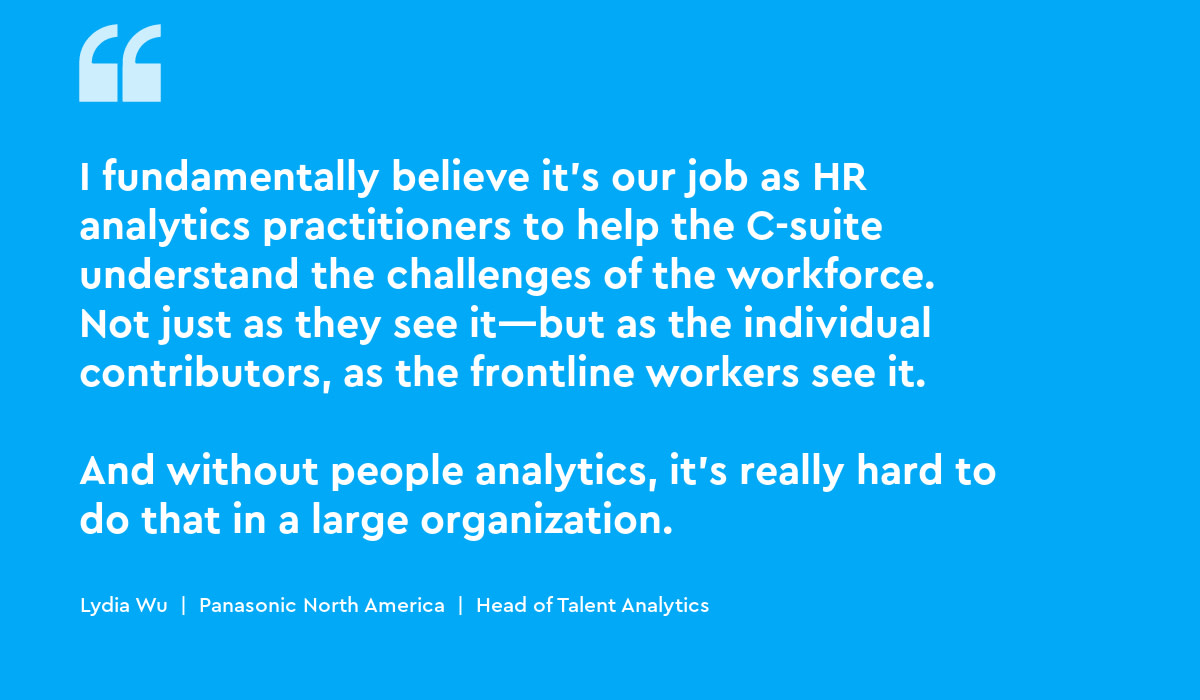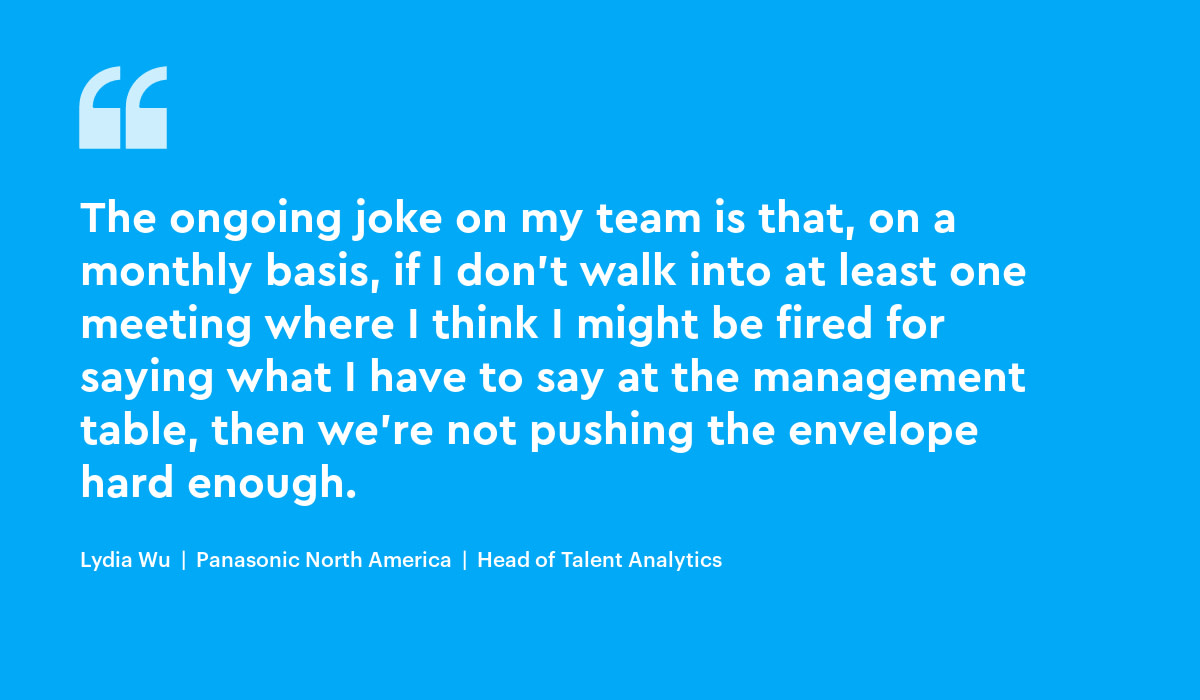Panasonic’s Lydia Wu on Establishing Confidence in Remote Work with People Analytics
How can you effectively measure remote work in different populations of workers? Lydia Wu of Panasonic has some ideas.

An interview with Lydia Wu, the Head of Talent Analytics and Transformation at Panasonic North America.
Hi Lydia! You’re the head of the talent analytics and transformation team at Panasonic North America—how did you end up in this line of work?
It was really back in the mid-2010s when Human Capital Management cloud implementations were all the rage—every single company was doing it. I found myself asking the question: “It’s great that we’re uploading all the data into the cloud, but what are we actually going to do with it?” And, because of that question, I got into HR analytics. Because, if you think about what marketing firms do with consumer data—and you think about the richness of employee data every single company holds—there’s quite a bit that we can do when it comes to employee satisfaction, engagement, and to really help drive business decision-making. That was a wealth of knowledge that HR departments weren’t tapping into at the time..

Lydia Wu is based in Newark, NJ where she leads the Talent Analytics and Transformation team at Panasonic North America.
You describe the team you lead as the “SWAT team of HR.” Why?
We’re the SWAT team that HR sends into any and all situations that are outside of the ordinary—special projects, a special initiative, a leadership decision that has to be made within the next two, three hours. But, at the end of the day, our focus is really on making sure we resolve all business challenges pertaining to talent. And most importantly, that we serve the best interest of our employees and our workforce always.

If you look back at the chaos that was 2020—and the ongoing pandemic today— can you recall a difficult or unprecedented business challenge that you and your team had to address?
We have about 15 office locations in the U.S., and typically all of our workforce work from these locations. We’ve historically had a flexible work policy, but the reality looked more like you were in the office about four or five days of the week unless you are a sales workforce and had to be on the road.
So one of the biggest challenges we had was supporting the organization going through a transformation that would have happened over the course of five or ten years, but happened literally within the time span of weeks. I’m sure you can imagine the number of decisions, the amount of uncertainty, the amount of insights that individuals required for decision-making. Not just for the business, but also for individual teams too.
What did you learn from that enormous global pivot in how your employees and managers work?
One of the biggest challenges at the onset of 2020 that we had to deal with was how do you build confidence in management teams? How do you build confidence in remote work so that managers are comfortable with their employees being remote, and more importantly, the employees are comfortable with their remote work setup as well. As that slowly progressed, with all of the social changes in 2020 were happening as well; what we recognized very quickly was that we can no longer treat our workforce as a homogenous group, but instead we need to take diversity, equity, and inclusion into account in all our decisions. This is where the whole conversation of intersectionality comes in at Panasonic as well, because how do you manage not only a geographically diverse workforce but a demographically and a socially diverse one?

Those are huge insights, so what will you take away from that time going into 2022 and beyond?
The ability of putting numbers to truly make the case that: Yes, well-being is important. Yes, burnout does drive turnover. Yes, flexibility does reduce burnout. Being able to statistically prove the different levers around potentially bringing people back to work for one day of the week—what would that look like from a burnout perspective? What would that look like from a turnover perspective? And then, truly being able to make a case to our company leadership to say, “Hey, I think this working remote business needs to continue, and genuinely your workforce will thank you for it.” And seeing these types of announcements made, seeing the policy changes made. That is what truly made the impact for us at the end of the day. And what we’ll carry forward.

You’re truly using data to put the people in “people analytics” first.
My team and I try to put the people in people analytics every day by making sure that everything we do is in the best interest of our employees, is reflective of our employee’s voice, and is reflective of our workforce’s intent. The ongoing joke on my team is that, on a monthly basis, if I don’t walk into at least one meeting where I think I might be fired for saying what I have to say at the management table, then we’re not pushing the envelope hard enough.
Let’s think about the future–what are the biggest challenges that your business expects to face in the next two to three years?
The understanding that after we’ve gone through 2020, after we finally understand the differences in intersectionality, the nuances of intersectionality, as we talk about diversity and inclusion, and as we talk about wellbeing, it’s about how do we include all of these aspects into the policy and into analysis? And ultimately, how do we help our talent counterparts, our HR business partner counterparts, implement those systems and decisions?
How will talent analytics help with those challenges?
Visier can definitely help us with some of this. And quite honestly, Visier already has in just being able to connect our employee engagement data with our demographics data, we now understand that our women workforce is not just homogenous. We have working mothers. We have gen Zs who are just coming into the workplace. We have baby boomers who have had long careers and still have a lot to offer. So for us, from an HR perspective, it’s really about how do you build and sustain policies and programs that include that entire population, and not just a certain demographic group as a descriptor group.
How do you take these ideas to the C-suite, to support business leaders in creating a data-driven culture throughout the organization?
I think people analytics data can support the C-suite in creating a data-driven organization by shining the spotlight on some really hard conversations that have been typically ignored in organizations. Going back to my original point, I always tell my team, “It’s not a good month if I don’t feel like I’m about to lose my job going into a decision-making meeting or a presentation.” Because I fundamentally believe it’s our job as HR analytics practitioners to help the C-suite understand the challenges of the workforce. Not just as they see it—but as the individual contributors, as the frontline workers see it. And without people analytics, it’s really hard to do that in a large organization.

You took our “What’s Your HR Superpower?” quiz and got “Strategy” as yours. Why do you think that having Strategy as a superpower is important in your line of work?
For me, having strategy is incredibly important because, in my mind, the role of people analytics is not to focus on the here and now. Of course, we offer very valuable insights to the here and now, but our goal is really to help orient our leaders in a longer-term position of: Where do we go from here in three to five years? How do we potentially get there? And what are some of the talent levers we really need to consider to help us position for success in the future? For me right now, that really means the focus on diversity, equity, and inclusion. A focus on overall employee wellbeing. And definitely ensuring the element of flexibility is there in how we work and when we work.
What do you think happens when HR pros lack this superpower?
I think what happens is they’re only zooming in on the here and now and putting blinders on. It may not be a bad thing when we’re reacting to a crisis situation, or when there’s an urgent decision to be made. However, if that is somebody’s 24/7 around the clock role, then the question becomes, who’s responsible for focusing on that longer-term strategy? And ensuring that your workforce is not just engaged in producing in the here and now, but also engaging in producing in the longer term.
Get Outsmart content straight to your inbox
Subscribe to the People Insights Monthly newsletter for actionable insights and stories.
Subscribe now